key Alfa Romeo GT 2006 Owner handbook (in English)
[x] Cancel search | Manufacturer: ALFA ROMEO, Model Year: 2006, Model line: GT, Model: Alfa Romeo GT 2006Pages: 307, PDF Size: 6.05 MB
Page 48 of 307
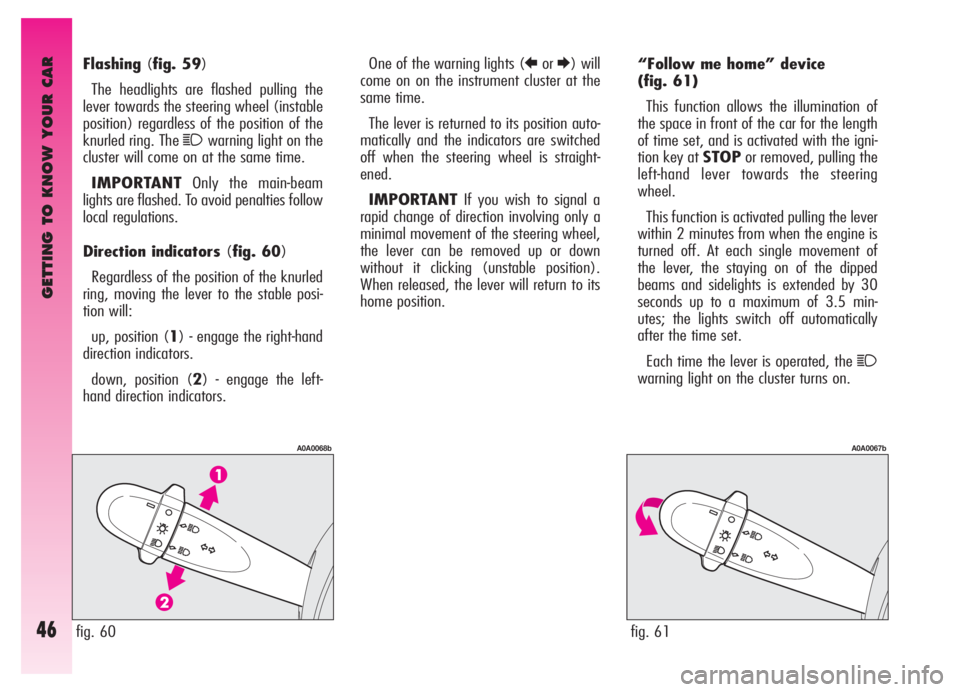
GETTING TO KNOW YOUR CAR
46
“Follow me home” device
(fig. 61)
This function allows the illumination of
the space in front of the car for the length
of time set, and is activated with the igni-
tion key at STOPor removed, pulling the
left-hand lever towards the steering
wheel.
This function is activated pulling the lever
within 2 minutes from when the engine is
turned off. At each single movement of
the lever, the staying on of the dipped
beams and sidelights is extended by 30
seconds up to a maximum of 3.5 min-
utes; the lights switch off automatically
after the time set.
Each time the lever is operated, the
1
warning light on the cluster turns on. Flashing(fig. 59)
The headlights are flashed pulling the
lever towards the steering wheel (instable
position) regardless of the position of the
knurled ring. The
1warning light on the
cluster will come on at the same time.
IMPORTANTOnly the main-beam
lights are flashed. To avoid penalties follow
local regulations.
Direction indicators (fig. 60)
Regardless of the position of the knurled
ring, moving the lever to the stable posi-
tion will:
up, position (1) - engage the right-hand
direction indicators.
down, position (2) - engage the left-
hand direction indicators.One of the warning lights (
RorE) will
come on on the instrument cluster at the
same time.
The lever is returned to its position auto-
matically and the indicators are switched
off when the steering wheel is straight-
ened.
IMPORTANTIf you wish to signal a
rapid change of direction involving only a
minimal movement of the steering wheel,
the lever can be removed up or down
without it clicking (unstable position).
When released, the lever will return to its
home position.
fig. 61
A0A0067b
fig. 60
A0A0068b
Page 50 of 307

GETTING TO KNOW YOUR CAR
48
At each start, the rain sensor automati-
cally stabilises at a temperature of about
40°C to eliminate any condensation from
the control surface and prevent the forma-
tion of ice.
The rain sensor is able to detect and
automatically adapt to the presence of the
following particular conditions which
require different sensitivity:
– impurities on the control surface (salt,
dirt, etc.);
– streaks of water caused by worn wiper
blades;
– difference between day and night (the
human eye is more disturbed during the
night by the wet glass surface). Rain sensor(fig. 64)
The rain sensor (A), fitted only on cer-
tain versions, is an electronic device com-
bined with the windscreen wiper which
has the purpose of automatically adjusting
the number of wipes during intermittent
operation to the intensity of the rain.
All the other functions controlled by the
right-hand lever remain unchanged.
The rain sensor is activated automatical-
ly moving the right-hand lever to position
(B-fig. 62) and it has a range of adjust-
ment that gradually varies between wiper
stationary (no wiping) when the wind-
screen is dry, to wiper at first continuous
speed (continuous, slow) with heavy rain.Turning the knurled ring (F-fig. 62) it
is possible to increase the sensitivity of the
rain sensor, obtaining a quicker change
from stationary, when the windscreen is
dry, to first continuous speed (continuous,
slow).
Operating the windscreen washer with
the rain sensor activated (lever at position
B) the normal washing cycle is performed
at the end of which the rain sensor
resumes its normal automatic function.
Turning the ignition key to STOPthe
rain sensor is deactivated and the next
time the engine is started (MAR posi-
tion) it will not be reactivated even if the
lever has remained in position (B). In this
case to activate the rain sensor, simply
move the lever to (A) or (C) and then
back to (B).
When the rain sensor is reactivated in
this way, the wiper performs at least one
stroke, even if the windscreen is dry, to
indicate that reactivation has occurred.
The rain sensor is located behind the
inner rear-view mirror in contact with the
windscreen and inside the area cleaned by
the wiper and it controls an electronic con-
trol unit which in turn controls the wiper
motor.
fig. 64
A0A0331b
Page 52 of 307
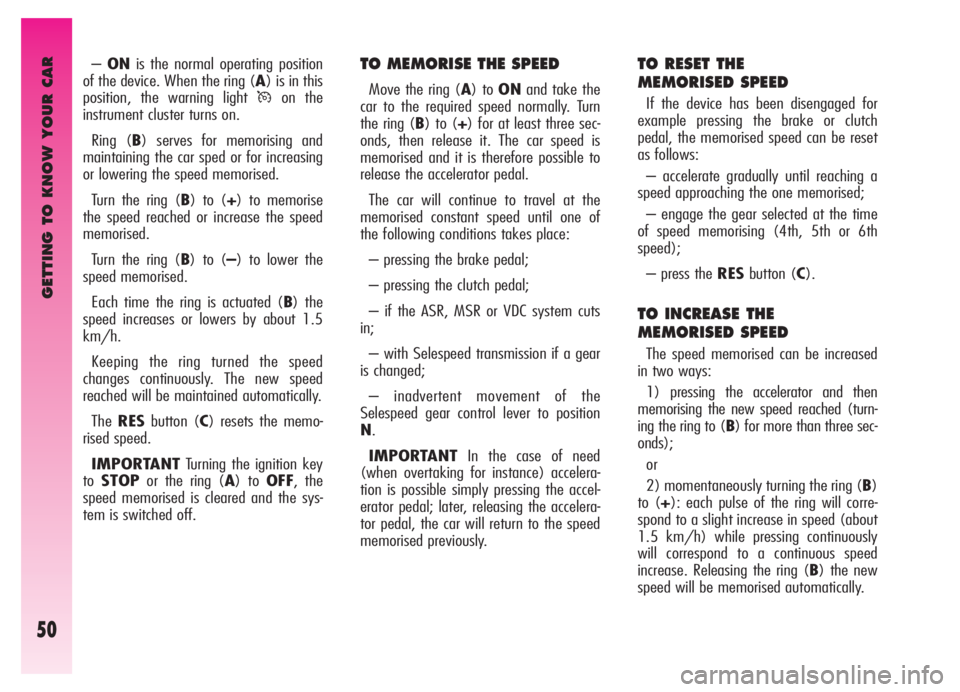
GETTING TO KNOW YOUR CAR
50
TO MEMORISE THE SPEED
Move the ring (A) to ONand take the
car to the required speed normally. Turn
the ring (B) to (+) for at least three sec-
onds, then release it. The car speed is
memorised and it is therefore possible to
release the accelerator pedal.
The car will continue to travel at the
memorised constant speed until one of
the following conditions takes place:
– pressing the brake pedal;
– pressing the clutch pedal;
– if the ASR, MSR or VDC system cuts
in;
– with Selespeed transmission if a gear
is changed;
– inadvertent movement of the
Selespeed gear control lever to position
N.
IMPORTANTIn the case of need
(when overtaking for instance) accelera-
tion is possible simply pressing the accel-
erator pedal; later, releasing the accelera-
tor pedal, the car will return to the speed
memorised previously.
TO RESET THE
MEMORISED SPEED
If the device has been disengaged for
example pressing the brake or clutch
pedal, the memorised speed can be reset
as follows:
– accelerate gradually until reaching a
speed approaching the one memorised;
– engage the gear selected at the time
of speed memorising (4th, 5th or 6th
speed);
– press the RESbutton (C).
TO INCREASE THE
MEMORISED SPEED
The speed memorised can be increased
in two ways:
1) pressing the accelerator and then
memorising the new speed reached (turn-
ing the ring to (B) for more than three sec-
onds);
or
2) momentaneously turning the ring (B)
to (+): each pulse of the ring will corre-
spond to a slight increase in speed (about
1.5 km/h) while pressing continuously
will correspond to a continuous speed
increase. Releasing the ring (B) the new
speed will be memorised automatically. –ONis the normal operating position
of the device. When the ring (A) is in this
position, the warning light
Üon the
instrument cluster turns on.
Ring (B) serves for memorising and
maintaining the car sped or for increasing
or lowering the speed memorised.
Turn the ring (B) to (+) to memorise
the speed reached or increase the speed
memorised.
Turn the ring (B) to (–) to lower the
speed memorised.
Each time the ring is actuated (B) the
speed increases or lowers by about 1.5
km/h.
Keeping the ring turned the speed
changes continuously. The new speed
reached will be maintained automatically.
TheRESbutton (C) resets the memo-
rised speed.
IMPORTANTTurning the ignition key
toSTOPor the ring (A) to OFF, the
speed memorised is cleared and the sys-
tem is switched off.
Page 54 of 307
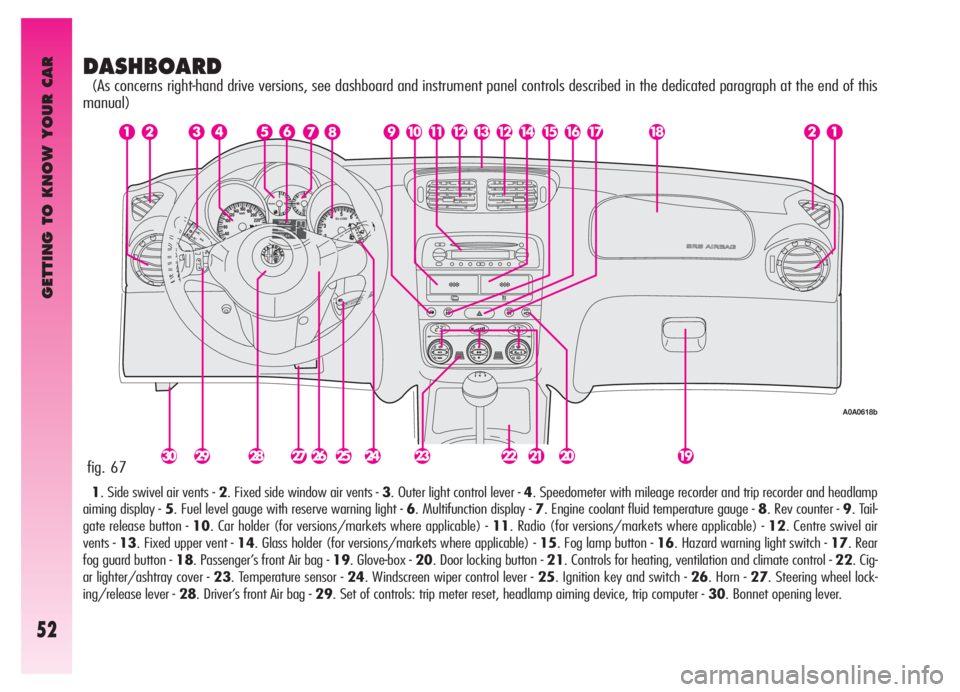
GETTING TO KNOW YOUR CAR
52
DASHBOARD
(As concerns right-hand drive versions, see dashboard and instrument panel controls described in the dedicated paragraph at the end of this
manual)
1. Side swivel air vents - 2. Fixed side window air vents - 3. Outer light control lever - 4. Speedometer with mileage recorder and trip recorder and headlamp
aiming display - 5. Fuel level gauge with reserve warning light - 6. Multifunction display - 7. Engine coolant fluid temperature gauge - 8. Rev counter - 9. Tail-
gate release button - 10. Car holder (for versions/markets where applicable) - 11. Radio (for versions/markets where applicable) - 12. Centre swivel air
vents - 13. Fixed upper vent - 14. Glass holder (for versions/markets where applicable) - 15. Fog lamp button - 16. Hazard warning light switch - 17. Rear
fog guard button - 18. Passenger’s front Air bag - 19. Glove-box - 20. Door locking button - 21. Controls for heating, ventilation and climate control - 22. Cig-
ar lighter/ashtray cover - 23. Temperature sensor - 24. Windscreen wiper control lever - 25. Ignition key and switch - 26. Horn - 27. Steering wheel lock-
ing/release lever - 28. Driver’s front Air bag - 29. Set of controls: trip meter reset, headlamp aiming device, trip computer - 30. Bonnet opening lever.
fig. 67
A0A0618b
Page 58 of 307
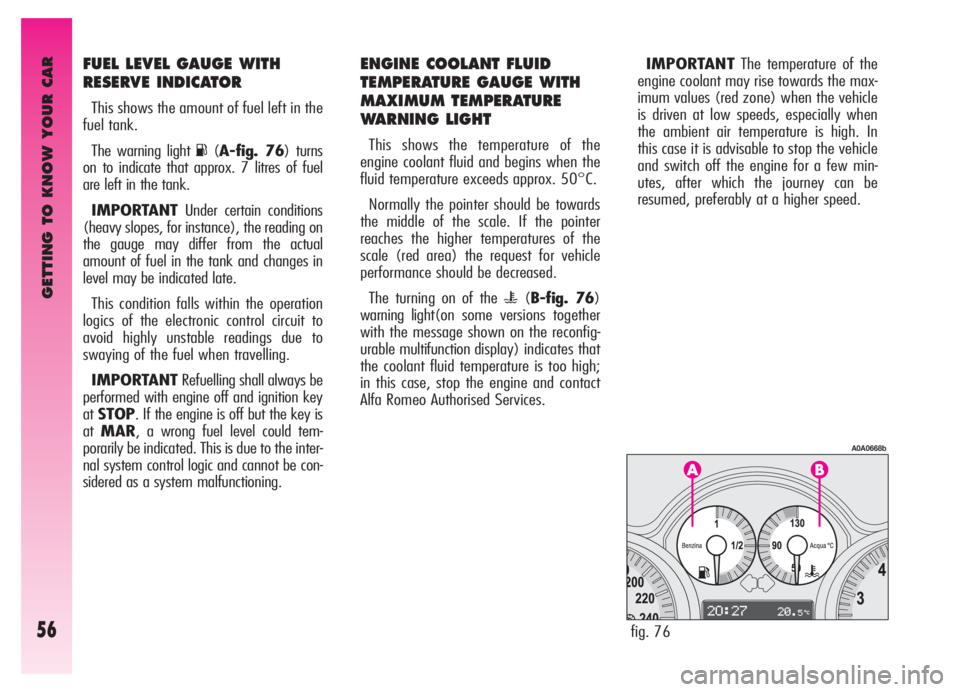
GETTING TO KNOW YOUR CAR
56
FUEL LEVEL GAUGE WITH
RESERVE INDICATOR
This shows the amount of fuel left in the
fuel tank.
The warning light
K(A-fig. 76) turns
on to indicate that approx. 7 litres of fuel
are left in the tank.
IMPORTANTUnder certain conditions
(heavy slopes, for instance), the reading on
the gauge may differ from the actual
amount of fuel in the tank and changes in
level may be indicated late.
This condition falls within the operation
logics of the electronic control circuit to
avoid highly unstable readings due to
swaying of the fuel when travelling.
IMPORTANTRefuelling shall always be
performed with engine off and ignition key
atSTOP. If the engine is off but the key is
atMAR, a wrong fuel level could tem-
porarily be indicated. This is due to the inter-
nal system control logic and cannot be con-
sidered as a system malfunctioning.
ENGINE COOLANT FLUID
TEMPERATURE GAUGE WITH
MAXIMUM TEMPERATURE
WARNING LIGHT
This shows the temperature of the
engine coolant fluid and begins when the
fluid temperature exceeds approx. 50°C.
Normally the pointer should be towards
the middle of the scale. If the pointer
reaches the higher temperatures of the
scale (red area) the request for vehicle
performance should be decreased.
The turning on of the
u(B-fig. 76)
warning light(on some versions together
with the message shown on the reconfig-
urablemultifunction display) indicates that
the coolant fluid temperature is too high;
in this case, stop the engine and contact
Alfa Romeo Authorised Services.IMPORTANTThe temperature of the
engine coolant may rise towards the max-
imum values (red zone) when the vehicle
is driven at low speeds, especially when
the ambient air temperature is high. In
this case it is advisable to stop the vehicle
and switch off the engine for a few min-
utes, after which the journey can be
resumed, preferably at a higher speed.
fig. 76
A0A0668b
Page 59 of 307
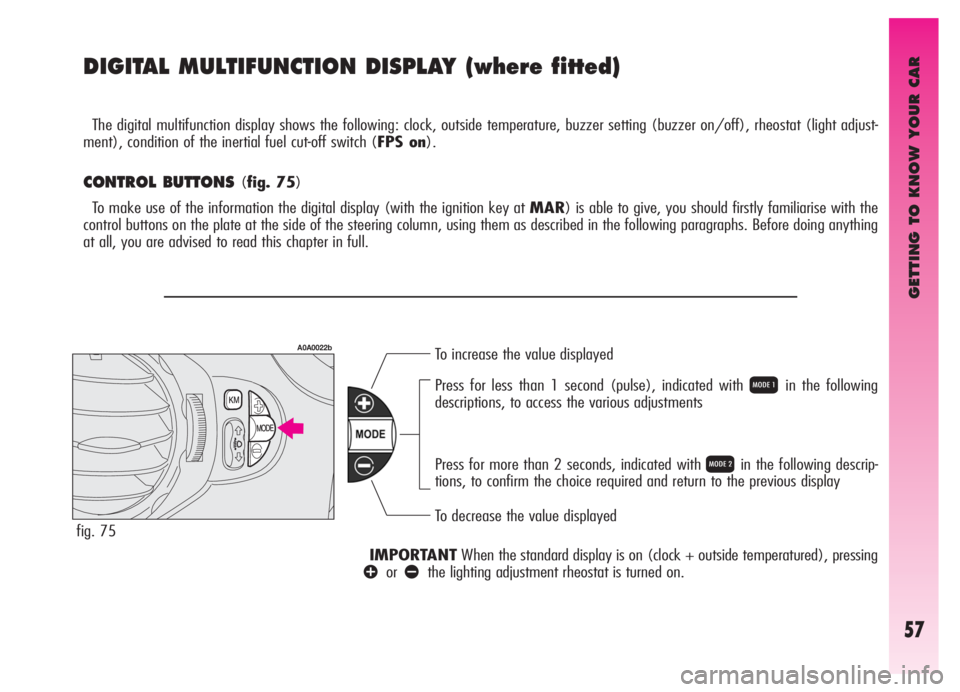
GETTING TO KNOW YOUR CAR
57
DIGITAL MULTIFUNCTION DISPLAY (where fitted)
The digital multifunction display shows the following: clock, outside temperature, buzzer setting (buzzer on/off), rheostat (light adjust-
ment), condition of the inertial fuel cut-off switch (FPS on).
CONTROL BUTTONS (fig. 75)
To make use of the information the digital display (with the ignition key at MAR) is able to give, you should firstly familiarise with the
control buttons on the plate at the side of the steering column, using them as described in the following paragraphs. Before doing anything
at all, you are advised to read this chapter in full.
To increase the value displayed
To decrease the value displayed Press for less than 1 second (pulse), indicated with
Qin the following
descriptions, to access the various adjustments
Press for more than 2 seconds, indicated with
Rin the following descrip-
tions, to confirm the choice required and return to the previous display
IMPORTANTWhen the standard display is on (clock + outside temperatured), pressing
âorãthe lighting adjustment rheostat is turned on.
fig. 75
A0A0022b
Page 63 of 307
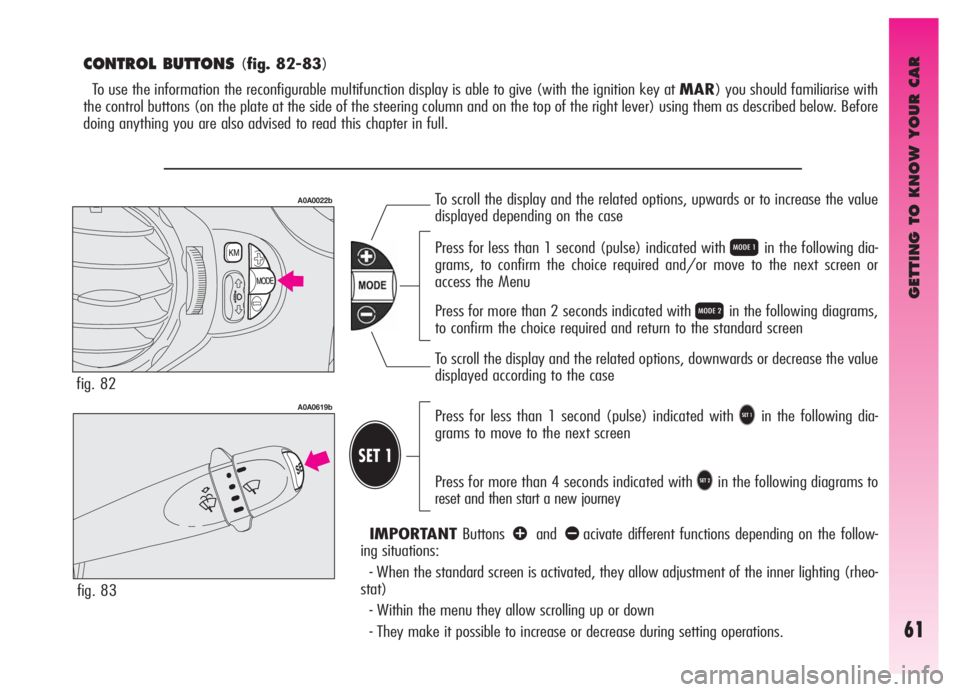
GETTING TO KNOW YOUR CAR
61
T
CONTROL BUTTONS (fig. 82-83)
To use the information the reconfigurable multifunction display is able to give (with the ignition key at MAR) you should familiarise with
the control buttons (on the plate at the side of the steering column and on the top of the right lever) using them as described below. Before
doing anything you are also advised to read this chapter in full.
fig. 82
fig. 83Press for less than 1 second (pulse) indicated with
Tin the following dia-
grams to move to the next screen
Press for more than 4 seconds indicated with
Uin the following diagrams to
reset and then start a new journey
To scroll the display and the related options, upwards or to increase the value
displayed depending on the case
To scroll the display and the related options, downwards or decrease the value
displayed according to the case Press for less than 1 second (pulse) indicated with
Qin the following dia-
grams, to confirm the choice required and/or move to the next screen or
access the Menu
Press for more than 2 seconds indicated with
Rin the following diagrams,
to confirm the choice required and return to the standard screen
A0A0022b
A0A0619b
IMPORTANTButtonsâandãacivate different functions depending on the follow-
ing situations:
- When the standard screen is activated, they allow adjustment of the inner lighting (rheo-
stat)
- Within the menu they allow scrolling up or down
- They make it possible to increase or decrease during setting operations.
Page 65 of 307
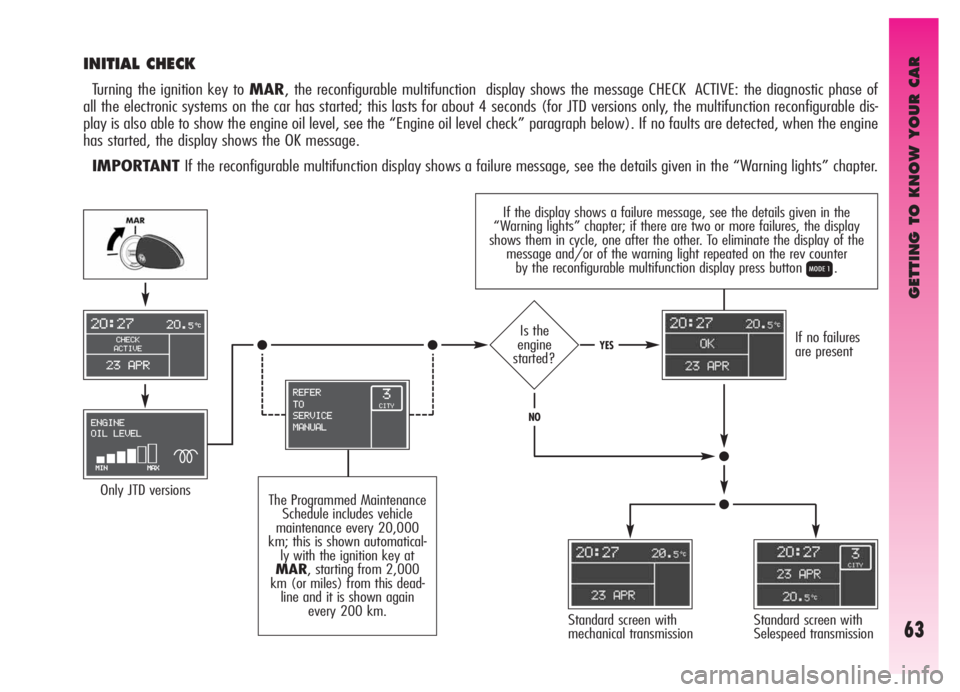
GETTING TO KNOW YOUR CAR
63
If the display shows a failure message, see the details given in the
“Warning lights” chapter; if there are two or more failures, the display
shows them in cycle, one after the other. To eliminate the display of the
message and/or of the warning light repeated on the rev counter
by the reconfigurable multifunction display press button
Q.
INITIAL CHECK
Turning the ignition key to MAR, the reconfigurable multifunction display shows the message CHECK ACTIVE: the diagnostic phase of
all the electronic systems on the car has started; this lasts for about 4 seconds (for JTD versions only, the multifunction reconfigurable dis-
play is also able to show the engine oil level, see the “Engine oil level check” paragraph below). If no faults are detected, when the engine
has started, the display shows the OK message.
IMPORTANT If the reconfigurable multifunction display shows a failure message, see the details given in the “Warning lights” chapter.
Standard screen with
mechanical transmission Only JTD versionsStandard screen with
Selespeed transmission
The Programmed Maintenance
Schedule includes vehicle
maintenance every 20,000
km; this is shown automatical-
ly with the ignition key at
MAR, starting from 2,000
km (or miles) from this dead-
line and it is shown again
every 200 km.
If no failures
are presentIs the
engine
started?YES
NO
Page 66 of 307
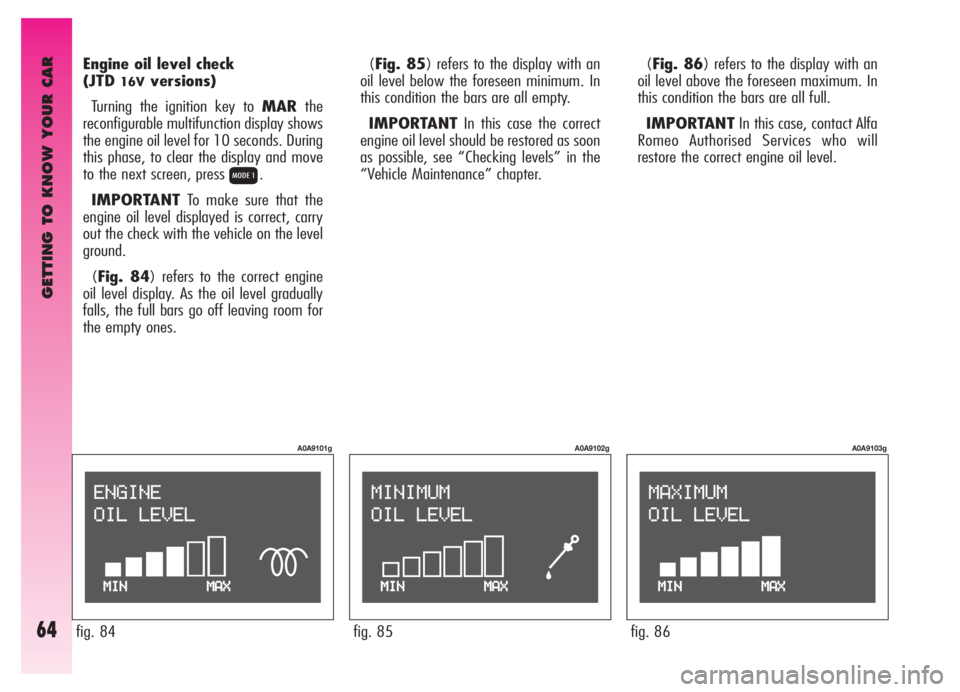
GETTING TO KNOW YOUR CAR
64
Engine oil level check
(JTD
16Vversions)
Turning the ignition key to MARthe
reconfigurable multifunction display shows
the engine oil level for 10 seconds. During
this phase, to clear the display and move
to the next screen, press
Q.
IMPORTANTTo make sure that the
engine oil level displayed is correct, carry
out the check with the vehicle on the level
ground.
(Fig. 84) refers to the correct engine
oil level display. As the oil level gradually
falls, the full bars go off leaving room for
the empty ones.
fig. 84
A0A9101g
fig. 85
A0A9102g
fig. 86
A0A9103g
(Fig. 85) refers to the display with an
oil level below the foreseen minimum. In
this condition the bars are all empty.
IMPORTANTIn this case the correct
engine oil level should be restored as soon
as possible, see “Checking levels” in the
“Vehicle Maintenance” chapter. (Fig. 86) refers to the display with an
oil level above the foreseen maximum. In
this condition the bars are all full.
IMPORTANTIn this case, contact Alfa
Romeo Authorised Services who will
restore the correct engine oil level.
Page 80 of 307
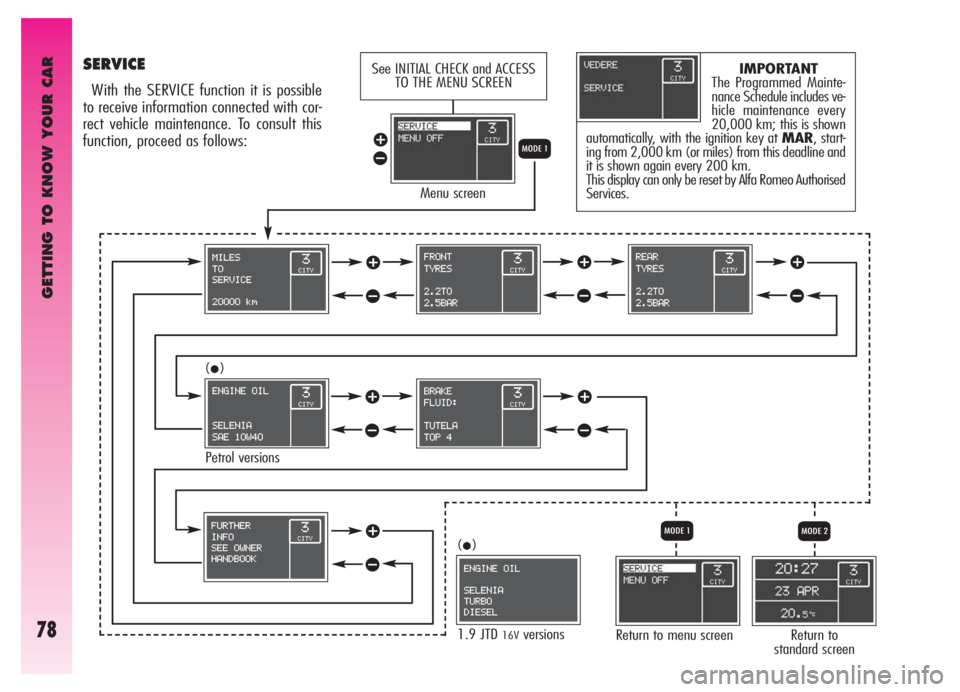
GETTING TO KNOW YOUR CAR
78
SERVICE
With the SERVICE function it is possible
to receive information connected with cor-
rect vehicle maintenance. To consult this
function, proceed as follows:
Menu screen
Return to menu screen
Return to
standard screen
IMPORTANT
The Programmed Mainte-
nance Schedule includes ve-
hicle maintenance every
20,000 km; this is shown
automatically, with the ignition key at MAR, start-
ing from 2,000 km (or miles) from this deadline and
it is shown again every 200 km.
This display can only be reset by Alfa Romeo Authorised
Services.
Q
QR
â
ã
â
ã
â
ã
â
ãâ
ã
â
ã
â
ã
See INITIAL CHECK and ACCESS
TO THE MENU SCREEN
Petrol versions
(
•) (
•)
1.9 JTD
16Vversions